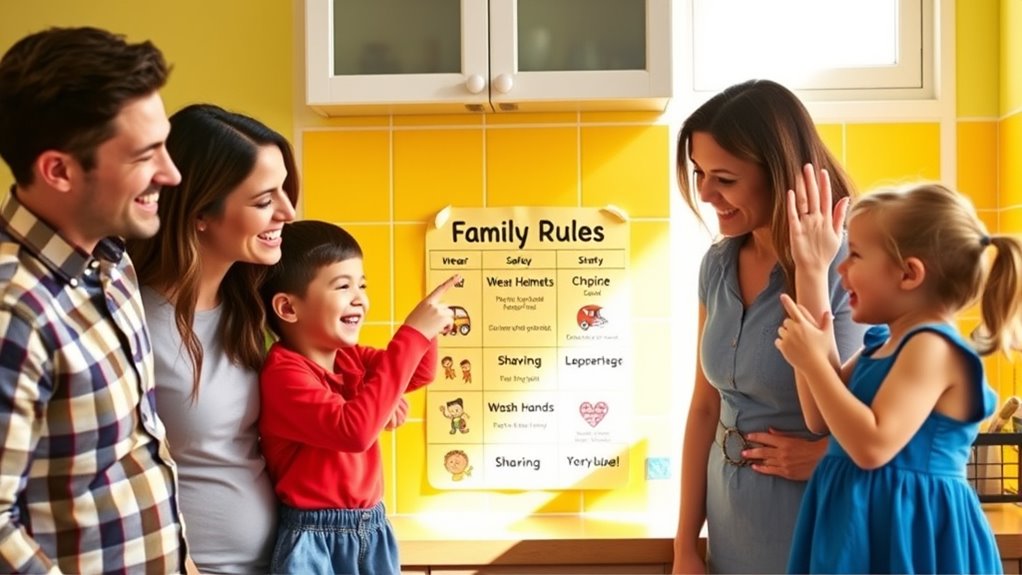Create clear play zones to keep activities organized and supervised. Set age-appropriate safety guidelines and teach proper use of tools and equipment. Encourage kids to follow rules consistently and supervise their outdoor and indoor activities. Establish boundaries for screen time and handle household items safely. Teaching respect, listening skills, and effective communication also builds a safe, fun family environment. Keep these rules in mind, and you’ll discover more ways to ensure fun and safety for everyone.
Key Takeaways
- Establish clear play zones and boundaries for activities to reduce chaos and prevent accidents.
- Set age-appropriate safety guidelines and teach proper use of equipment for safer play.
- Supervise children actively and enforce consistent rules to prevent injuries and promote safety.
- Promote respectful communication and listening to build trust and a positive family environment.
- Define boundaries for screen time and indoor activities to ensure fun while minimizing risks.
Establish Clear Play Zones
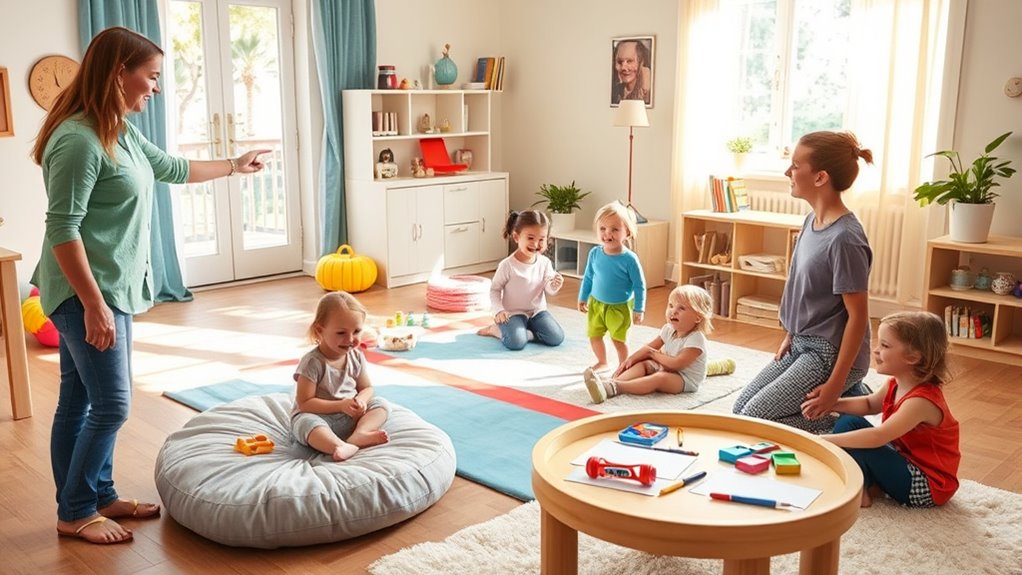
Creating designated play zones helps your family stay organized and reduces chaos. By setting specific areas for different activities, you make it easier for everyone to know where toys, games, and crafts belong. Use clear boundaries, like rugs or furniture arrangements, to define each space. This prevents toys from spreading all over the house and keeps clutter manageable. When kids know their play area, they develop a sense of responsibility for cleaning up afterward. Additionally, designated zones help you supervise activities more efficiently and prevent conflicts over shared spaces. Keep these zones consistent, and encourage your children to respect them. Simple visual cues, like labels or color codes, can reinforce boundaries and make cleanup routines smoother for everyone. Monitoring social media giveaways can also be a fun way to motivate kids with extra rewards for keeping their zones tidy.
Set Age-Appropriate Safety Guidelines
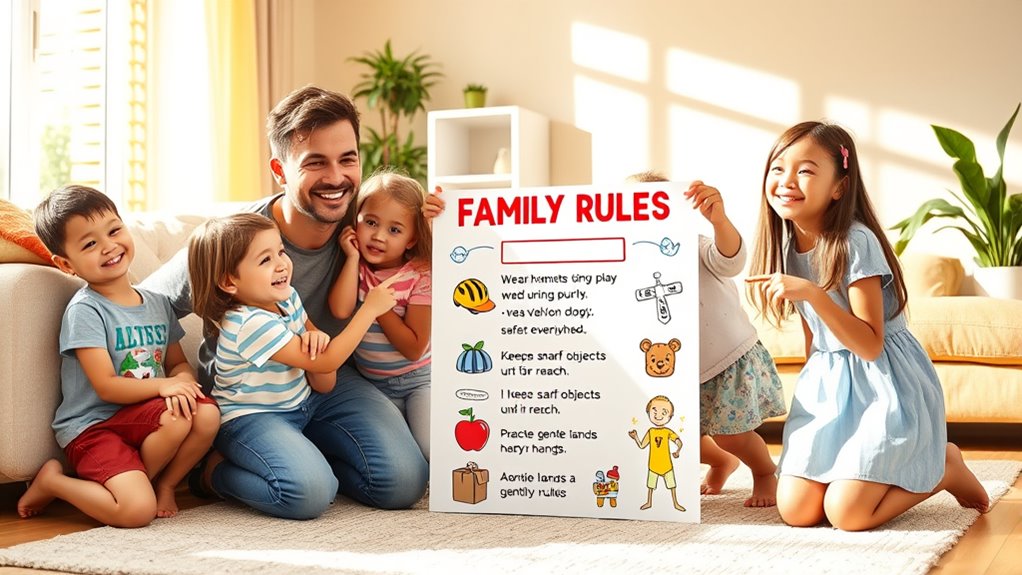
Establishing safety guidelines that match your child’s age is essential for preventing accidents and fostering independence. Younger children need close supervision and simple rules, like no running in the house or touching hot objects. As they grow, introduce more specific safety measures, such as wearing helmets when riding bikes or using age-appropriate car seats. Keep instructions clear and consistent, explaining why certain rules exist. Adjust the rules as your child develops new skills and understanding. For example, teach older kids about boundaries around electrical outlets or small objects they shouldn’t put in their mouths. Setting realistic, age-specific expectations helps your child learn safety habits without feeling overwhelmed. Regularly revisit and update guidelines to match their evolving abilities and ensure they stay safe. Recognizing beach safety tips can also help you prepare for family trips to top beach destinations.
Encourage Proper Use of Equipment
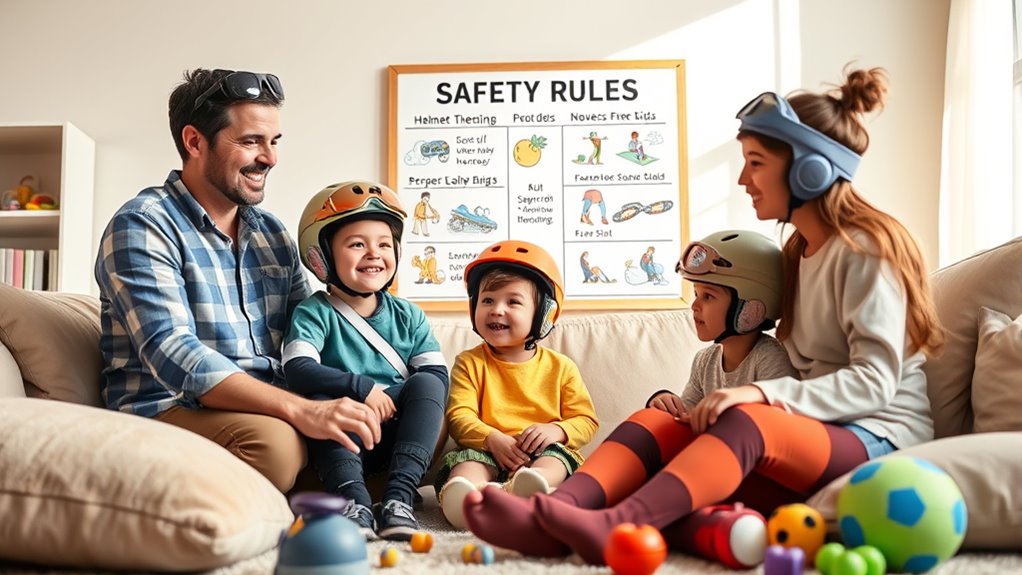
To guarantee your child’s safety, it’s important to teach them how to use equipment properly from the start. Show them how to operate tools, appliances, and outdoor gear safely, emphasizing the importance of reading instructions and following safety labels. Demonstrate correct techniques and supervise their initial use until they’re confident. Encourage your child to ask questions if they’re unsure about how something works or feels unsafe. Remind them that rushing or taking shortcuts can lead to accidents. Reinforce the idea that equipment should always be used as intended, never modified or misused. Understanding proper maintenance and care ensures the equipment functions safely and effectively, reducing the risk of malfunctions. By establishing these habits early, you help your child develop respect for safety rules and reduce the risk of injuries during play or chores.
Teach the Importance of Supervision
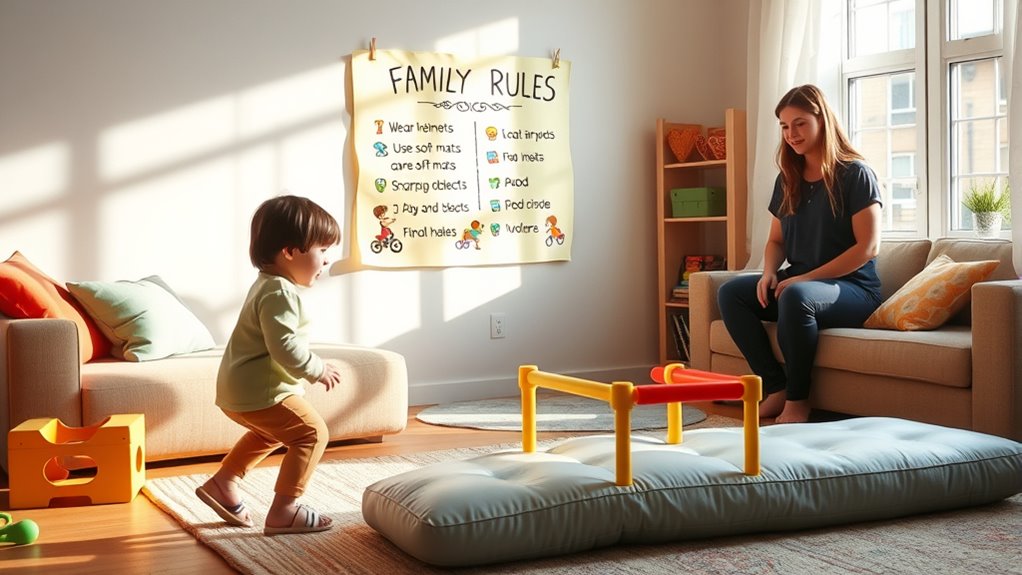
Supervision is essential to keep your child safe while they explore and learn. When you actively watch your child, you can prevent accidents before they happen and quickly respond if needed. Keeping an eye on them doesn’t mean hovering, but being present and attentive. For example, when your child is playing with toys, you can ensure they’re using age-appropriate items and not putting small objects in their mouth. During outdoor activities, supervision helps you spot potential hazards like sharp tools or uneven ground. Consistent supervision builds trust and shows your child you’re there to keep them safe. Remember, active supervision is a key rule that balances freedom with safety, allowing your child to learn and have fun without unnecessary risks. Understanding the importance of constant supervision can further enhance their safety during play.
Define Boundaries for Screen Time and Indoor Activities

You need to set clear daily limits for screen time so your kids know when it’s time to stop. Creating designated activity zones helps them understand which spaces are for specific activities. These boundaries give everyone structure and promote healthier indoor routines. Implementing consistent rules around screen time management can further reinforce these boundaries and encourage balanced indoor activities.
Set Daily Limits
Setting clear daily limits helps children develop healthy habits and manage their time effectively. By establishing specific boundaries for screen time and indoor activities, you teach your kids to balance work, play, and rest. Decide on reasonable durations for screen use each day and communicate these rules clearly. Use timers or visual cues to help children stay aware of their limits and avoid overuse. Consistency is key—stick to the limits you set, even on weekends. This approach prevents excessive screen time, reduces distractions, and encourages engagement in other activities. When children understand their boundaries, they feel more secure and learn self-control. Additionally, understanding the importance of well-being tips can help families create a healthier routine. Ultimately, setting daily limits promotes healthier routines, reduces conflicts, and helps your family enjoy a balanced, fun-filled environment.
Establish Activity Zones
Establishing designated activity zones within your home helps children understand where different activities should take place, making boundaries clear and consistent. By defining specific areas for screen time, homework, and play, you reduce confusion and promote responsible behavior. You can set a quiet corner for reading, a play area for toys, and a separate spot for devices. Use visual cues like rugs or signs to reinforce boundaries. Here’s a simple way to organize:
| Zone | Purpose | Rules |
|---|---|---|
| Living Room | Family movies, games | No screens during dinner |
| Bedroom | Rest, homework | Keep electronics off at night |
| Play Area | Toys, creative activities | Clean up after use |
| Kitchen | Snacks, family meals | Supervise, set time limits |
| Office/Desk | Homework, work | Keep work materials organized |
Clear zones help keep your home safe, fun, and well-organized. Incorporating user experience (UX) principles into your zone setup can further enhance safety and usability.
Promote Safe Handling of Household Items and Toys
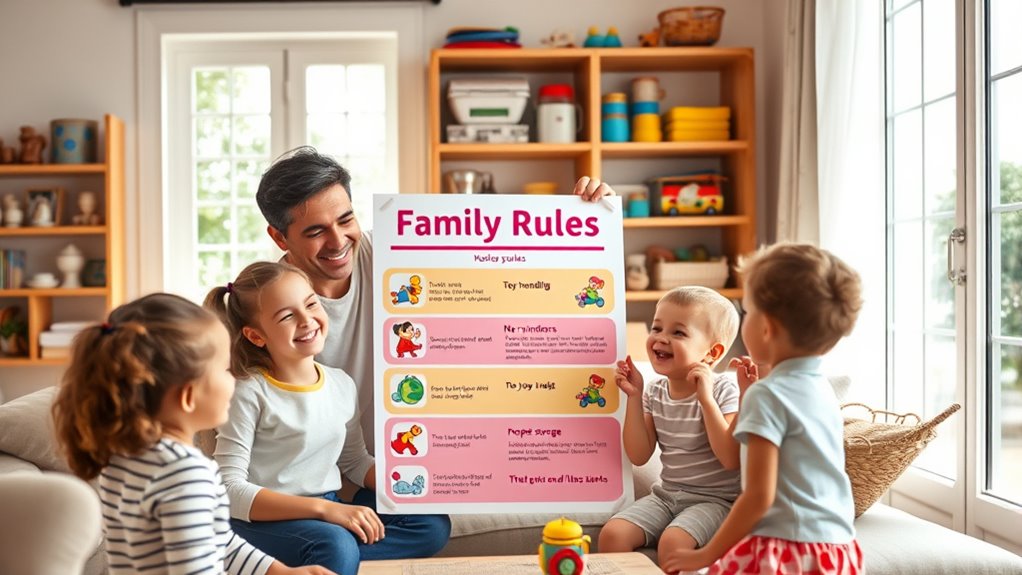
Ensuring children handle household items and toys safely is essential to prevent accidents and injuries. Teach them to use items as intended and avoid shortcuts that could cause harm. Show them how to carry sharp or heavy objects carefully, keeping their fingers away from edges. Encourage proper storage of toys, so they don’t pose tripping hazards or tempt kids to play unsafely. Make sure they know which items are off-limits, like cleaning supplies or tools, and keep those out of reach. Regularly check toys for damage, like broken parts or loose pieces, and discard unsafe items. Reinforce the importance of gentle handling and respect for household objects. By promoting mindful use, you help children develop safe habits that protect them and keep your home accident-free. Additionally, understanding WWE Raw’s financial impact can help parents explain the importance of responsible entertainment consumption.
Reinforce the Value of Listening and Respecting Rules

Listening demonstrates respect and helps everyone feel heard. When you follow rules consistently, it builds trust and smooths daily routines. Clear communication guarantees everyone understands expectations and feels valued. Paying attention to appropriate skincare ingredients can also promote overall well-being and confidence.
Listening Shows Respect
Have you ever noticed how respectful listening can strengthen your relationships? When you truly listen, you show others you value their thoughts and feelings. This builds trust and encourages open communication. Respectful listening also prevents misunderstandings and conflicts. To illustrate, here’s a simple way to see its importance:
| Listening | Respecting Others’ Ideas | Building Trust |
|---|---|---|
| Focus on the speaker | Acknowledge their feelings | Feel heard and valued |
| Avoid interruptions | Show you’re interested | Strengthen bonds |
| Ask questions | Clarify without judging | Foster understanding |
Additionally, understanding resources and tools available can help you develop better communication skills.
Follow Rules Consistently
When you listen carefully and respect others’ ideas, it becomes easier to follow rules consistently. Showing that you value rules by sticking to them reinforces their importance for everyone. When you follow rules every time, you create a predictable environment where everyone feels safe and respected. Consistency also helps prevent accidents because everyone knows what to expect and how to act. If you forget or ignore a rule once, others might think it’s okay to do the same, which can lead to problems. By practicing consistency, you set a good example for family members and encourage them to do the same. Over time, following rules becomes a natural habit, making your home more fun, safe, and respectful for everyone involved.
Communicate Clearly Always
Why is clear communication so important when it comes to following family rules? When everyone understands what’s expected, there’s less confusion and more cooperation. If you speak openly and listen carefully, misunderstandings decrease, and respect grows. Clear communication helps family members express their needs and concerns without frustration. It encourages a culture of honesty and trust, making it easier to enforce rules and resolve conflicts. When you communicate clearly, you show that you value each person’s perspective, fostering mutual respect. Remember, listening is just as important as speaking. By reinforcing the importance of respectful dialogue, you create a safe environment where everyone feels heard and valued. This foundation of clear communication keeps your family connected, fun, and safe.
Frequently Asked Questions
How Can I Make Rules Fun Without Losing Their Importance?
You can make rules fun by turning them into games or challenges that everyone looks forward to. Use colorful charts, reward systems, or storytelling to explain why rules matter. Get kids involved in creating the rules so they feel ownership. Keep the tone light and positive, praising good behavior. This way, rules feel less like chores and more like part of the family adventure, maintaining their importance while keeping things lively.
What Are Signs My Child Understands Safety Rules?
You’ll know your child understands safety rules when they follow them consistently and explain why they’re important, showing they’ve truly grasped the concept. If they remind others, ask questions, or can demonstrate what to do in different situations, that’s a clear sign they’ve got it. When your child makes safety a second nature, it’s like they’ve got safety rules on the ball, making everyone feel more secure.
How Do I Handle Rule-Breaking Calmly and Effectively?
When your child breaks a rule, stay calm and speak gently. Explain why the rule is important and listen to their perspective. Use positive reinforcement when they understand, and set clear consequences if needed. Avoid yelling or showing frustration, as this can scare or confuse them. Consistency helps your child learn, so follow through with the same response each time to reinforce good behavior calmly and effectively.
Should Rules Differ for Visiting Friends’ Homes?
Yes, rules should differ when visiting friends’ homes, but they should still be respectful and safe. Talk to your kids beforehand about the specific rules of the new environment, emphasizing the importance of respecting others’ boundaries and property. Encourage them to be adaptable and polite, while also reminding them of their own family rules. This helps guarantee everyone has fun and stays safe during the visit.
How Often Should Safety Rules Be Reviewed or Updated?
You should review and update safety rules at least once every six months to keep them current and effective. Whenever your child’s routines change, new hazards appear, or after an incident, it’s important to revisit these rules. Regular reviews guarantee everyone understands safety expectations, and updates help address evolving risks. Staying proactive about safety keeps your home secure and your family prepared, making fun times safer for everyone.
Conclusion
By gently guiding your family with these friendly rules, you create a warm environment where everyone can enjoy themselves safely. When boundaries are clear and everyone understands the importance of listening, you help prevent little bumps along the way. Remember, a well-tended play space isn’t just about safety—it’s about nurturing trust and respect. Keep the fun flowing smoothly by embracing these gentle guidelines, and everyone will feel more secure and happy together.
